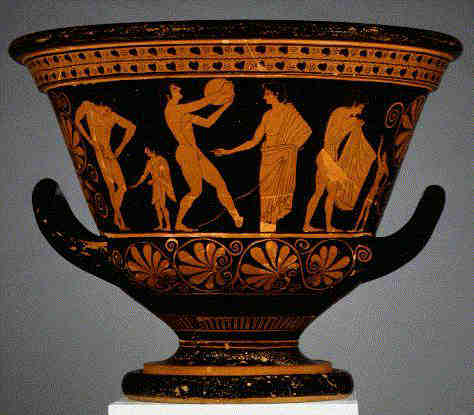 ead, a honey wine, is probably the most
ancient of fermented
beverages. Its production and ceremonial use may well have begun
in the proto-cities of the ancient Near East more than eight
thousand years ago. Our remote ancestors drank mead and
attributed the state of intoxication to the spirit of a god.
Historian Jane Harrison recognizes the traditional mead-making
craft as a precursor of classical Greek religion: ead, a honey wine, is probably the most
ancient of fermented
beverages. Its production and ceremonial use may well have begun
in the proto-cities of the ancient Near East more than eight
thousand years ago. Our remote ancestors drank mead and
attributed the state of intoxication to the spirit of a god.
Historian Jane Harrison recognizes the traditional mead-making
craft as a precursor of classical Greek religion:
- "... there was a time when leavened bread was not, and men
ate porridge cooked or uncooked, so before the coming of the vine
men drank a honey drink. And as the conservative gods, long after
men ate fermented bread, were faithful to their porridge, so long
after men drank wine they still offered to the gods who were
there before the coming of the vine 'wineless libations,'
nêphália." (1)
- "Mythology has left us dim hints as to the functions of
certain ancient maiden prophetesses at Delphi called
Thriae." (2)
- "The Thriae are nurses like the Maenads, they rave in holy
madness (thuíousin) ... but their inspiration is not from
Bacchos, the wine-god ... ; it is from a source, from an
intoxicant yet more primitive, from honey. They are in a word
'Melissae,' honey-priestesses, inspired by a honey
intoxicant ..." (3)
- "... not only the priestesses of Artemis at Ephesus were
'Bees,' but also those of Demeter, and, still more significant,
the Delphic priestess herself was a Bee." (4)
In more recent centuries, newlyweds drank mead daily in celebration of the
first month of married life, believing that this would ensure the birth of sons.
This is the origin of the word, honeymoon.
Cindy Renfrow has compiled over a hundred distinct recipes for
mead, many from a compilation printed in 1669. (5) This appears
to be a Welsh text, The Closet of the Eminently Learned Sir
Kenelme Digby, Knight, Opened. (6) These recipes encompass a
great volume of medieval experimentation with herbs, spices, and
fruit additives. One also observes the great concern with methods
of purifying the water of sediment and other undesirable
substances. Rainwater was often used, allowing several months for
any dust particles to settle out. A number of the recipes call
for a lengthy series of preliminary boiling and skimming
operations to render the water suitable for use.
Most interesting is a simple mead formula recorded by Pliny the
Elder in the year 77 CE:
- "... a wine is also made of only water and honey ... adding
one part of old honey to three parts of water, and then keeping
the mixture in the sun for forty days after the rising of the
Dog-star. Others pour it off after nine days and then cork it up.
This beverage is called in Greek 'water-honey', hydromeli;
with age it attains the flavor of wine." (7)
I followed this proportion of water to honey in making my own
meads. Technically, a mead prepared with spices is known as a
metheglin. Endless varieties are possible. Typically, I
like to add three or four slices of fresh ginger, a stick of
cinnamon,
and a teaspoon or so of rosemary to a gallon batch of mead.
A bit of citrus peel makes a nice addition. Cloves in any
quantity tend to add a bitterness not to everyone's taste. I
recommend dispensing with cloves altogether or using but one or
two per gallon.
Several of the commercially-produced meads I had sampled in years
past were more than a bit disappointing in taste. My family and
friends encouraged me to try my own hand at it, and so I did,
beginning just two months ago. Here below are the practical steps
which I have used in producing mead:
- 1. Heat 3 liters of pure (reverse osmosis) water.
- 2. Add spices to near-boiling water; typically cinnamon
stick, a few slices of fresh ginger root, and approx. 1 teaspoon
rosemary.
- 3. Add 1 liter (approx. 1.1 kg) honey. I have used raw local
(Arizona) honey (mesquite and wildflower predominating).
- 4. Stir thoroughly to dissolve honey, quickly removing the
mix from heat, to preserve volatile components of the honey.
- 5. Add a little warm water to dissolve dry yeast placed in
the bottom of a clean gallon storage pitcher. A suitable pitcher
has a closed cover, but not fully airtight.
- 6. Allow mix to cool to 40 - 45 Celsius range, about the
warmth of milk for baby's bottle. Transfer from pot to storage
pitcher, mixing with the yeast.
- 7. Wrap pitcher loosely in black plastic to protect against
intense sunlight and provide a bit of insulation. A delicate
fragrance will grow as fermentation begins.
- 8. Allow to stand four days, then strain spices from
partially fermented mixture. You may, in straining it, hear the
buzzing of the bees. The mead priestesses of old must have found
this a wondrous sound indeed!
- 9. Return to pitcher to continue fermentation or transfer to
reusable strong bottles. Good bottles are those sold with Fischer
d'Alsace or Grolsch beer. The mead can be refrigerated in these
if carbonation is desired. Be careful when opening! The yeast
could also be filtered to produce a clearer still mead.
- 10. The mead can be enjoyed in a few days or allowed to age
for months. Enjoy!

References:
- (1) Harrison, Jane. Prolegomena to the Study of Greek
Religion. Princeton: Princeton University Press, 1991., p.90.
- (2) ibid., p.441.
- (3) ibid., p.442.
- (4) ibid.
- (5) Renfrow, Cindy. A Sip Through Time: A Collection of
Old Brewing Recipes. self-published, Pottstown, PA: 1995.
- (6) Dilley, J., Dunn, D., Manteufel, T., Tighe, M. The
Mead-Lovers README file. revision 14, 1995.
- (7) Pliny the Elder, Natural History, Book XIV,
section XX, p.261, H. Rackham, ed. Harvard Univ. Press.
Cambridge, MA: 1938.
Return to ''Enduring Beauty and Majesty''
|


 ead, a honey wine, is probably the most
ancient of fermented
beverages. Its production and ceremonial use may well have begun
in the proto-cities of the ancient Near East more than eight
thousand years ago. Our remote ancestors drank mead and
attributed the state of intoxication to the spirit of a god.
Historian Jane Harrison recognizes the traditional mead-making
craft as a precursor of classical Greek religion:
ead, a honey wine, is probably the most
ancient of fermented
beverages. Its production and ceremonial use may well have begun
in the proto-cities of the ancient Near East more than eight
thousand years ago. Our remote ancestors drank mead and
attributed the state of intoxication to the spirit of a god.
Historian Jane Harrison recognizes the traditional mead-making
craft as a precursor of classical Greek religion: